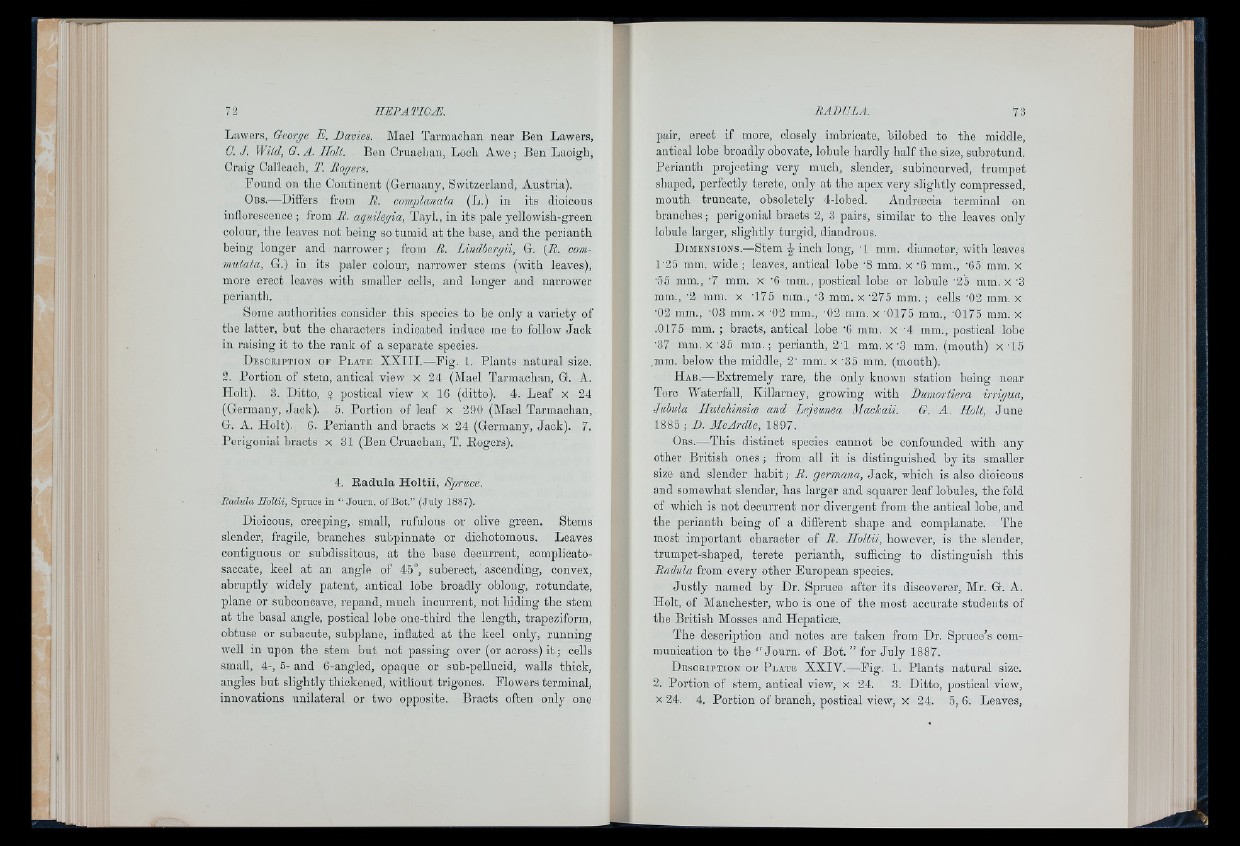
Lawers, George E. Davies. Mael Tarmaolian near Ben Lawers,
C. J. mid, G. A. Holt. Ben Cruaolian, Loch Awe; Ben Laoigh,
Craig Cal'leach, T. Rogers.
Found on the Continent (Germany, Switzerland, Austria).
O bs.—Differs from R. complanafa (L.) in its dioicous
inflorescence ; from R. aquilegia, Tayl., in its pale yellowish-green
colour, the leaves not being so tumid at the base, and the perianth
being longer and narrower ; from R. Lindbergii, G. {R. com-
mutata, G.) in its paler colour, narrower stems (with leaves),
more erect leaves with smaller cells, and longer and narrower
periantli.
Some autiiorities consider this species to be only a variety of
the latter, but the characters indicated induce me to follow Jack
in raising it to the rank of a separate species.
D esciuptio.n op P late X X IIL—Pig. 1. Plants natural size.
2. Portion of stem, antical view x 24 (Mael Tarmachan, G. A.
Holt). 3. Ditto, ¥ postical view x 16 (ditto). 4. Leaf x 24
(Germany, Jack). 5. Portion of leaf x 290 (Mael Tarmachan,
G. A. Holt), 6. Perianth and bracts x 24 (Germany, Jack). 7.
Perigonial bracts x 31 (Ben Cruachan, T. Eogers).
4. Radula Holtii, Spruce.
Radula Holtii, Spruce in “ Journ. of B ot.” (Ju ly 1887).
Dioicous, creeping,, small, rufulous or olive green. Stems
slender, fragile, branches subpinnate or dichotomous. Leaves
contiguous or subdissitous, at the base decurrent, oomplicato-
saocate, keel at an angle of 45°, suberect, ascending, convex,
abruptly widely patent, antical lobe broadljr oblong, rotundate,
plane or subconcave, repand, mucli incurrent, not liiding the stem
at tlie basal angle, postical lobe oue-third the length, trapeziform,
obtuse or subacute, subplane, inflated at the keel only, running
well in upon the stem but not passing over (or across) i t ; ceils
small, 4-, 5- and 6-angled, opaque or sub-pelluoid, walls thick,
angles but slightly thickened, without trigones. Flowers terminal,
innovations unilateral or two opposite. Bracts often only one
pair, erect if more, closely imbricate, bilobed to the middle,
antioal lobe broadly obovate, lobule hardly half tlie size, subrotund.
Perianth projecting very much, slender, subinourved, trumpet
shaped, perfectly terete, only at tlie apex very sliglitly compressed,
mouth truncate, obsoletely 4-lobed. Andrcecia terminal on
branches ; perigonial bracts 2, 3 pairs, similar to the leaves only
lobule larger, slightly turgid, diandrous.
D imensions.—Stem J inch long, T mm. diameter, with leaves
1'25 mm. wide ; leaves, antical lobe '8 mm. x -6 mm., '65 mm. x
•55 mm., -7 mm. x -6 mm., postical lobe or lobule -2'5 mm. x -3
mm., '2 mm. x ^175 mm., •S mm. x ^275 mm. ; cells ^02 mm. x
•02 mm., -03 mm. x -02 mm., '02 mm. x '0175 mm., 0175 mm. x
.0175 mm. ; bracts, antical lobe '6 mm. x '4 mm., postical lobe
•37 m m .x '35 mm.; perianth, 2'1 mm. x '3 mm. (mouth) x '15
,mm. below the middle, 2' mm. x '35 mm. (mouth).
H ab.—Extremely rare, the only known station being near
Tore Waterfall, Killarney, growing with Dumortiera irrigua,
Jubula HutcMusics and Lejeunea Mackaii. G. A. Holt, June
1885 ; D. McArdle, 1897.
Obs.—This distinct species cannot be confounded with any
other British ones ; from all it is distinguished by its smaller
size and slender habit ; B. germana. Jack, which is also dioicous
and somewhat slender, has larger and squarer leaf lobules, tlie fold
of which is not decurrent nor divergent from tlie antioal lobe, and
the perianth being of a different shape and complánate. The
most important character of R. Holtii, however, is the slender,
trumpet-sliaped, terete perianth, sufficing to distinguish this
Radula from every other European species.
Justly named by Dr, Spruce after its discoverer, Mr. G. A.
Holt, of Manchester, who is one of the most accurate students of
the British Mosses and Hepaticæ.
The description and notes are taken from Dr. Spruce’s communication
to the “ Journ. of Bot. ” for July 1887.
D escription or I’i.ate XXIV.—Fig. 1. Plants natural size.
2. Portion of .stem, antical view, x 24. 3. Ditto, postical view,
X 24. 4, Portion of branch, postical view, x 24. 5, 6, Leaves,